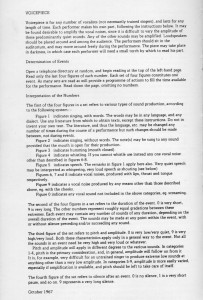Well, normally we’d avoid doing a video watch on the same composer twice, but this was just too good to miss. This video, called ‘Making Music with the Alabaster Lithophone’ is presented as part of an art auction to benefit Music in the Round, a Sheffield music association (presumably referring to Sheffield’s famous Crucible Theatre, which presents drama and snooker in the round — although not at the same time, sadly).
The Alabaster Lithophone is the creation of the artist Vivien Whitaker, and the music is by Chris Hobbs. Here’s the first part of an interview by Fraser Wilson with Chris:
No, Christopher Hobbs, founder of the EMC, is not master of disguises, nor of time and space. Nor has he bleached his hair, had youth drugs and plastic surgery (sorry Christopher!), and started wearing glasses for seeing rather than just reading. This Chris Hobbs is a composition student at Sheffield University, only 80 miles away from EMC’s headquarters in Leicester. And he has produced some very nice sounds on the Alabaster Lithophone, which is a wonderful instrument. It’s something that would have graced Harry Partch’s orchestra, had it been tuned to his specifications.
Here’s the second part of this interview:
The only flaw in this Chris Hobbs Alabaster Lithophone video is that there is too much interview and not enough Lithophone. And it’s not that we don’t like the cadet Chris Hobbs — in fact, we’re agog to see more from him — but it’s the fact that the interviewer questions him as if it were 1913, not 2013 (he’s surprised that there are no tunes). But this attitude seems to be worth dealing with in the comments section, so do get in touch and let us know what you think. And Sheffield Chris, if you see this, say hi!
Now we’d do a video watch to find the doppelgängers of all the EMC composers, but if we started on John White or Dave Smith, that’s all we’d do. Something for the long winter nights, we think. To conclude, we think it best to say, ‘Know your Hobbs!’ (Know your Hobbses?). So here’s a test: one, a picture of the Sheffield Chris Hobbs from the video (there’s one of him dancing on his Google page); the other, EMC Christopher Hobbs playing a chair on an AMM concert on Clapham Common in the early 1970s (as one does), when he was about the same age as Sheffield Chris Hobbs. Can you tell which is which? Answers below, should you need them.
Answer below:
Christopher Hobbs, founder of the EMC, is on the left; Chris Hobbs, Alabaster Lithophone virtuoso, on the right. Did we fool you?




